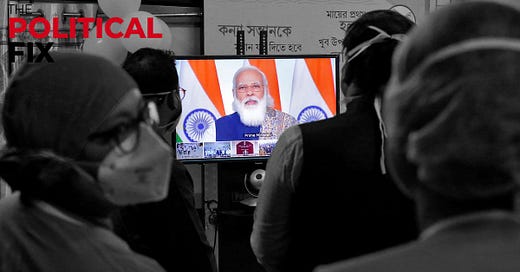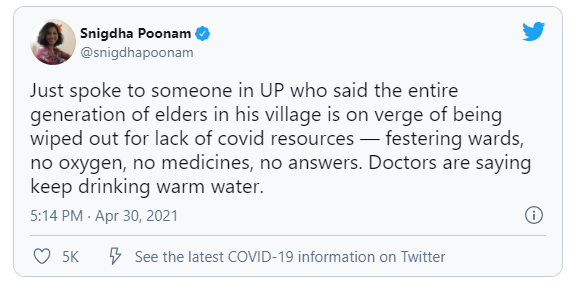The Political Fix: Is the Modi government battling the virus – or fighting narrative wars?
A newsletter on politics and policy from Scroll.in.
Welcome to The Political Fix by Rohan Venkataramakrishnan, a newsletter on Indian politics and policy. To get it in your inbox every week, sign up here.
India’s second Covid-19 wave is a huge story. Help our small team cover the big issues. Contribute to the Scroll Reporting Fund or subscribe to Scroll+.
The Big Story: Plot hole
Did the Indian government fail to act in time to contain the massive second wave of Covid-19 because the top leaders of the ruling party were more focused on an election campaign in West Bengal – in which it would eventually be handed an enormous defeat?
Narrative is important to Narendra Modi. Indeed, it is all encompassing. For the Indian prime minister, no public appearance is a one-off. No speech is routine. A banal flyover inauguration is an opportunity to attack the Opposition for its failures in the past. A visit by a foreign leader is portrayed as recognition of India’s growing stature, powered single-handedly by the prime minister. The end of an election campaign is a chance to be photographed meditating in a cave, driving home the idea that Modi is a selfless fakir.
This constant crafting of storylines is often derided by critics, convinced that the Indian prime minister is simply an “event manager”. But it is also fundamental to Modi’s remarkable political success, as many have explained before – including this newsletter.
Each narrative plot-point is like another wall in the prime minister’s meticulously constructed fortress, and they all come in handy when the facts threaten to burst through.
Demonetisation fails? Modi only has to retreat behind the facade of “saaf niyat”, right intent, and wait until the siege is lifted. China intrudes on Indian territory? Modi simply has to invoke his image as a tireless, nationalist defender of Bharat Mata, Mother India, while his minions spread the message that anyone asking questions is anti-national. Economy struggling? The prime minister reminds you that he is a poor man’s son, and insists that hard work trumps Harvard – meaning economists.
The best encapsulation of the success of Modi’s narrative building is the phrase, “Modiji ne kiya to soch samajh ke kiya hoga”, if Modi did it then, he must’ve put some thought into it.
How do we know this brand management is vital for Modi? As India was attempting to handle the first wave of Covid-19 and the subsequent migrant crisis in 2020, a Group of Ministers met six times how to “neutralise” independent media and push the state narrative. The entire document makes for fascinating reading.
‘Cry babies’
Unfortunately, a government geared entirely around narrative management could lose its grip on reality.
What else explains Union Health Minister Harsh Vardhan claiming last week that India was better prepared to beat Covid-19 this year than 2020, even as patients around the country were dying of a lack of oxygen or hospital beds? How else to process Solicitor General Tushar Mehta’s labelling of those asking for oxygen to save people’s lives as “cry babies”?
What other way is there to respond to Haryana Chief Minister ML Khattar’s claim that there is no point discussing if Covid-19 deaths are being undercounted because they won’t come back to life anyway? How are families of those who have died, not because of the virus but because of the lack of basic care, supposed to feel about Harsh Vardhan boasting about India having the lowest fatality rate in the world?
The events of May 2 are an important example.
Healthcare has been a free-for-all in Delhi over the past two weeks, as Covid-19 cases exploded and the city ran out of hospital beds, key medicines and oxygen. Supriya Sharma’s essay on struggling to find care for her family in the city is a glimpse of what things have been like in the capital.
The youth wing of the Congress has been one of the organisations that have managed to assist many in their search for oxygen or medicines via social media, which means it also gets tagged in requests for help incessantly.
So when on May 1 it emerged that the Indian Youth Congress had provided oxygen cylinders to the embassy of the Philippines in New Delhi, it seemed a sign of just how bad things had gotten in the capital: not only that a foreign mission needed its own medical supplies, but that it received them from a unit of the Opposition party.
On May 2, India’s External Affairs Minister S Jaishankar tried to sow doubts about the sequence of events, making the dubious claim that the Philippines Embassy had simply accepted an “unsolicited” gift of oxygen after the Youth Congress turned up at its gates.
The Young Congress later put out more evidence of the cylinders being requested by the foreign mission, but not before the New Zealand High Commission had taken to Twitter to also ask the same organisation for oxygen as well. It also winded up receiving cylinders from the Youth Congress, but also deleted its tweet – and then found itself apologising for soliciting medical help.
Evidently, instead of reassuring foreign missions that their needs would be taken care of, the Indian Ministry of External Affairs decided to go on the attack against them – simply because the Opposition had supplied them with oxygen. The ministry said as much in leaks to the media and in attacks by ideologues online, though a spokesperson insisted afterward that officers were in touch with all the embassies on these matters.
Missed warnings
Did narrative concerns have a role to play in India failing to spot and contain its brutal Covid-19 second wave?
It certainly seemed evident in mid-April that the top leadership of the government was spending more time on the eight-phase election battle in West Bengal – in which Modi’s Bharatiya Janata Party were soundly defeated (more on this below) – than on the need to contain the disease. It was only at the very end that Modi pivoted to holding high-level meetings on the Covid-19 crisis, and cancelled large election rallies in the state.
But it may also have played out in reverse where instead of “evidence-based policy making”, India got “policy-based evidence making”.
Modi declared victory over Covid-19 in February, saying India’s example was inspiring the world. By March, Health Minister Harsh Vardhan said India was in the “endgame”.
Reuters reports that around this time, “a forum of scientific advisers set up by the government warned Indian officials in early March of a new and more contagious variant of the coronavirus taking hold in the country... [Yet] the government took no steps to prevent gatherings that might hasten the spread of the new variant, as new infections quadrupled by April 1 from a month earlier.”
Indeed, not only did it not take steps to prevent gatherings, it actively encouraged them, both at election rallies but also at the Kumbh Mela in Uttarakhand, with millions gathering on the banks of the Ganga.
Now models suggest India is looking at a peak of up to 1 million cases a day, even as the Centre insists that it will not impose a national lockdown. This itself is a reflection of how – despite narrative claims of its success in 2020 – that harsh tool was utilised without much planning last year while case counts were still low.
Whether or not India’s Covid-19 response would have been any different if elections were not taking place in West Bengal, the visuals of Modi holding large rallies are now inextricably linked with the damage caused by the second wave.
Neither saaf niyat nor hard work over Harvard will work here, since both have been expended. And there is no convenient villain to blame. The prime minister had already declared victory over the virus, so an unexpected calamity can’t be blamed, even if it is a variant. In the early weeks of the pandemic in 2020, the BJP IT Cell blamed Muslims but the abiding images of the second wave have been the Kumbh Mela, the scenes of desperation outside hospitals and overburdened crematoriums. While the Right is attacking the foreign press for showing the truth and calling for Indians to project positivity, it seems unlikely that any family in major cities is untouched by the devastation of this wave.
Whether that means anything politically for Modi is a complex question, though a few have taken a stab at answering.
More worryingly, the Philippines and New Zealand High Commission episode make it evident that the government remains more committed to guarding Modi and his government’s image than supporting all efforts to tide over this crisis.
Over the last month, the narrative walls have been breached. India’s Covid-19 second wave is by far the biggest challenge Modi has faced and not one that can be defeated with a surgical strike or burying data, and certainly not by labelling those asking for help as “cry babies” or bragging about India’s fatality rate when people are dying without oxygen. Moreover, for a prime minister who has chosen to stay somewhat above the fray since 2019, the risks are tremendous.
This is an all-hands-on-deck moment. Will the government continue diverting half of its effort towards shoring up the personal brand of the captain instead of focusing entirely on keeping the ship afloat?
Election Watch
India’s devastating Covid-19 situation and the haphazard response from the government remain the top story. But Sunday’s election results were significant. We will have more coverage of the outcome this week, but here are the key bits:
In West Bengal, the Trinamool Congress pulled off a major victory over the BJP, which was hoping to build on its strong Lok Sabha showing in 2019. The Trinamool Congress was leading in 213 seats, way above the 148-seat halfway mark, with the BJP a distant second at 77. Chief Minister Mamata Banerjee was, however, defeated in a tight contest by her former aide, Suvendu Adhikari, in his pocket borough of Nandigram. Banerjee can remain chief minister, as long as she is re-elected from another seat in the state within six months. The Left-Congress combine was routed.
In Tamil Nadu, the Dravida Munnetra Kazhagam will take over after 10 years of All India Anna Dravida Munnetra Kazhagam rule. The DMK is on course for more than 159 seats, in an Assembly where the halfway mark is 118. In a state where big sweeps are common, though, the AIADMK alliance’s 75-seat performance is being seen as a sign that it was stronger than expected. MK Stalin will be chief minister.
In Assam, despite all the tumult over the National Register of Citizens and the Citizenship Act amendments, the BJP will return to power, with its alliance leading in 75 seats, 10 ahead of the halfway mark. The Congress-led grand alliance is likely to pick up 50 seats. The intrigue in the state is over whether current Chief Minister Sarbananda Sonowal will be retained, or whether Himanta Biswa Sarma has a shot at the throne.
In Kerala, the Communist-led Left Democratic Front broke an almost four-decade long tradition of power see-sawing between the two main coalitions, by retaining the state and keeping the Congress-led United Democratic Front out. The halfway mark is 74, with LDF at 99 and UDF at 41. Chief Minister Pinarayi Vijayan will return, with his image even more burnished, despite the Congress success at the Lok Sabha polls two years ago. The BJP, which had one seat previously, went down to 0.
In the Union Territory of Puducherry, the All India NR Congress-BJP alliance was on course to win the state, previously held by the Congress-DMK alliance, until it fell to a confidence vote just weeks before the elections.
Thanks for reading the Political Fix. Send feedback to rohan@scroll.in.
Support our journalism by subscribing to Scroll+. We welcome your comments atletters@scroll.in.









Well written.But who listens?